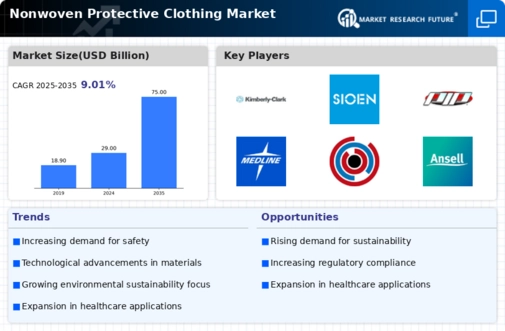Expansion of End-User Industries
The Global Nonwoven Protective Clothing Market Industry benefits from the expansion of end-user industries, including healthcare, construction, and food processing. As these sectors grow, the demand for protective clothing that meets specific industry requirements intensifies. Nonwoven materials, known for their lightweight and breathable properties, are increasingly favored in applications where comfort and protection are paramount. This trend is likely to drive market growth, as companies seek to equip their workforce with effective protective solutions. The interplay between industry expansion and the need for advanced protective clothing underscores the market's potential for sustained growth in the coming years.
Rising Awareness of Health Risks
Growing awareness of health risks associated with exposure to hazardous materials propels the Global Nonwoven Protective Clothing Market Industry forward. Industries such as healthcare and chemical manufacturing are increasingly recognizing the importance of protective clothing in safeguarding workers from potential health hazards. This awareness drives investments in high-quality nonwoven protective gear, which is designed to provide effective barriers against contaminants. As a result, the market is poised for substantial growth, with projections indicating a potential increase to 75.0 USD Billion by 2035, reflecting the critical role of protective clothing in promoting occupational health and safety.
Increasing Demand for Safety Gear
The Global Nonwoven Protective Clothing Market Industry experiences a notable surge in demand for safety gear across various sectors, including healthcare, construction, and manufacturing. This heightened demand is primarily driven by the growing awareness of workplace safety regulations and the necessity for protective clothing to mitigate risks associated with hazardous environments. As industries prioritize employee safety, the market is projected to reach 29.0 USD Billion in 2024, reflecting a robust growth trajectory. The emphasis on nonwoven materials, which offer superior barrier protection and comfort, further enhances the appeal of these products, indicating a shift towards more effective safety solutions.
Regulatory Compliance and Standards
The Global Nonwoven Protective Clothing Market Industry is significantly influenced by stringent regulatory frameworks and safety standards established by governmental bodies. Compliance with these regulations is essential for manufacturers and end-users alike, as they ensure that protective clothing meets specific performance criteria. This regulatory landscape fosters a competitive environment, compelling companies to innovate and enhance their product offerings. As industries adapt to these regulations, the demand for compliant nonwoven protective clothing is anticipated to grow, further solidifying the market's position as a critical component of workplace safety strategies.
Technological Advancements in Materials
Technological innovations in nonwoven fabric production significantly influence the Global Nonwoven Protective Clothing Market Industry. Advanced manufacturing techniques, such as spunbond and meltblown processes, enhance the performance characteristics of protective clothing, including durability, breathability, and fluid resistance. These advancements not only improve the functionality of protective gear but also contribute to cost-effectiveness, making nonwoven options more attractive to end-users. As a result, the market is expected to witness a compound annual growth rate of 9.01% from 2025 to 2035, driven by the continuous evolution of material technologies that cater to diverse industry needs.
























Leave a Comment